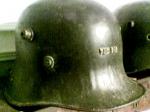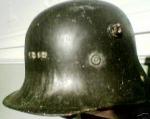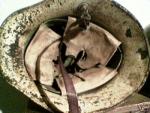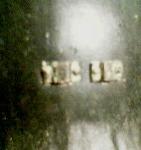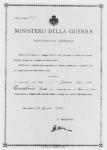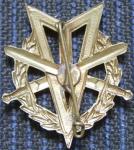-
Posts
9,099 -
Joined
-
Last visited
-
Days Won
4
Content Type
Profiles
Forums
Blogs
Gallery
Events
Store
Everything posted by Kev in Deva
-
Hallo Jeff welcome to the Host Club Kevin in Deva
-

Austria-Hungary Interesting Tunic & Awards
Kev in Deva replied to Nick's topic in Austro-Hungarian Empire
You mean Old Whas-isname from AUSSTRO-UNGERIEA??? Nice bit a sheep there allright. Kevin- -
Hallo Roeland, this one has stumped the experts as well, it has many simeralities with your in shape and design but is a breast badge. I thought it could possibly connected to a shooting club or veterans club as an unofficial award but maybe "stogieman" is on the right track? Can you post pictures of te rear of these items??? Kevin.
-

Picture of Adolf at a 1933 Dortmund Rally.
Kev in Deva replied to Kev in Deva's topic in State, Civil Awards & Decorations
Thanks Nick, Kevin -
Hallo joemiller, page 355 of Orden & Ehrenzeichen 1800 - 1945 by J?rg Nimmergut (2005/2006) shows a 1914 bar (2538) similar to the one you show in your picture. page 353 S?chsische Herzogt?mer ab 1826 section, page 353 is written: 2538 wie vor, mit Schwerterspange >>1914<< f?r Kriegsvedienst, ab 1915. Sv/Sv. As before, but with Sword spange 1914 for War service from 1915, Sv/Sv = Silver Gilt, then goes on to list the dates "1914/5", "1914/6", "1914/7", "1914/8", and finaly a "1918" Sword Spange. Kevin.
-
Hallo Chris, I found this link to Spanish helmet website, might be worth contating the owner maybe he can i.d. your lid IF it is in fact of Spanish origin. http://www.gostak.demon.co.uk/helmets/spain.htm He makes this reference with regards a TRUBIA Spanish helmet: "Original issues would NOT have had the clasp for a national insignia welded to the front; that was added at the end of the Civil War after the victory of the fascist Franco. Just luv the quote from his site: " SPAIN MODELO Z liner. Most definitely not a German wartime M42 when it has the later, web-cradle liner fitted in 1979, making it actually an M42-79. Anyone selling these as genuine German M42s on ebay or elsewhere should be prosecuted for deception and fraud. Or stoned in the streets, which ever is the more satisfying." Kevin
-

Pistol Relic River find in Transylvania.
Kev in Deva replied to Kev in Deva's topic in Firearms & Ordnance
Hallo Kjell, many thanks for the super quick answer, A beer on me in the Lounge for that It looks very close, a few minor differences but I put that down to model changes over the time between 1855 - 1856 - 1860. Apparently remains of a rifle were found nearby but as that was in better condition it was handed into the police!!! Kevin. -
Hallo Gents, this weekend we are entertaining our "God-Children" stems from a quaint Romanian tradition which normally involves the childs god-parents being involved in the wedding ceremony when the children get married, in this case I inherited my wife's niece, as her original "God-Parants" from the time of her baptism, could'nt make it to the wedding last year. At the wedding I got to give away the bride at the Registery Office ceremony and at the Orthadox Church wedding on the same-day. Well Cosmina & Eugen arrived this morning for a visit and Eugin told me he had a piece of militaria that his brother had found in the river Mures last Autum, they were moving sand and gravel from the river when from under a large stone about 4 meters down they turned up this: The barrel length is 16,5 cm. The silver nuts and bolts he added to keep it from falling apart, the barrel is hexagonal in shape on the outside, and the chamber was fitted for 5 shots, with the back of the chambers being fitted for "nipples", the bullets being hand loaded, after the approprite charge of black-powder is poured into the chambers. The original wooden grips are still there and the pattern can still be seen on the wood, which is now a rusty red colour. If you need to see bigger pictures please PM me your email address. Kevin
-

Netherlands Dutch Carte de Visite's
Kev in Deva replied to Herr General's topic in Northern European & Baltic States
Hallo Gents, Seems to be an interesting thread, BUT I can't see the following pictures, when I look at these pages: CDV- 1 - 2 - 3 -5 - 6 . CDV - 4 close up, CDV - 5, Close up, CDV - 7 close up, Any reasons why?? Kevin in Deva. -

Netherlands DUTCH MILITARY SPORTS BADGE
Kev in Deva replied to Kev in Deva's topic in Northern European & Baltic States
Hallo Eric, many thanks for the information on this, any chance you have a picture of the UNIFIL one? being an old IRISH UNIFIL vet it would be interesting to see one Kevin in Deva -
ITALY Continued: WOUND STRIPE: Despite the intensions expressed in the regulations governing Wound Badge awards, they were apparently interpreted with what the War Department construed to be excessive generosity. Consequently, a subsequent Circular (No. 182, 12 March, 1917) redifined criteria with more precision, while simultaneously introducing a new insignia.The latter was to be granted to individuals wounded or injured while on active service, but the extent of the severity precluded award of the Wound Badge under revised and more rigorous regulations.The new emblem, a length of silver braid measuring 5 by 50mm, was to be worn on the right sleeve of the tunic. To emphasize its importance, the governing regulations specified that it was to be worn above all other rank or qualification badges.Qualification for the Wound Strip was based on serious injury; superficial cuts, bruises and so forth did not qualify. Only wounds or specific types of injuries sustained during actual combat were considered. For example, frostbite injuries, - a distinct possibility under the winter alpine conditions - were, quite reasonably, deemed to be acceptable, if unavoidably incurred during service at the Front. So also were injuries due to Poison gas, Liqued fire, and similar weapons. Claimants were entitled to one Wound Stripe for each occasion on which a qualifying wound was suffered, i.e., wounds received simultaneously did not qualify for individual stripes. All recipients of the Wound Badge, including those receiving if for service prior to the Great War, were automatically granted the Wound Stripe as well. Award of the Wound Stripe was the responsibility of the Corps and Depot commanders, and all such awards were to be recorded in the permanent service record of the recipient. However, officers commanding hospitals or convalescent establishments could also approve awards, provided that the individuals involved had been attached to their units for 60 days or more.As with the Wound Badge, provision were made for appeal of refused applications.Finally, in an effort to avoid the problems earlier encoutered with the Wound Badge, Commanding Officers were instructed to avoid excessive generosity in their recomendations. Subsequently the nature of the Wound Stripe was amended on a number of occasions. For example, Royal Decree No. 831 of 3 March, 1923, provided for an insignia of similar pattern and dimensions, but in red, for those wounded in the Fascist Revolution. This was later discontinued. Most substantive changes were promulgated in Circular No. 912 of the Ministry for War issued in 1934. This replaced the original silver Wound Stripe with Gold and Silver Stripes. The gold Wound Stripe was reserved for wounds sustained in Combat. The silver version was thenawarded for wounds or injuries incurred while on active military service, but not a direct consequence of enemy action. (Hopefully a GMIC Member might have a picture of the Italian Wound Stripe as none is featured in the above mentioned book!) UNIT WOUND CERTIFICATES: In additin to the foregoing official awards, some individual units apparently also provided recognition of wounds sustained in action. Other items connected with the above are here listed as well, if any information pertaining them is required or of interest I would be happy to post it from the book. CROCHE Di GUERRA. CONDOLENCE CERTIFICATE. MEDAL FOR THE MOTHERS OF THE FALLEN BADGE OF HONOR FOR THE ORPHANS OF WAR DEAD, CITY OF ROME WOUND MEDAL Finaly, reference should be made to the bulletin isued on 10th October, 1919, by the ministerial section responsible for the Distinctions and Compensations.This outlines regulations adopted in respect to wear of war decorations with civilian dress. Several of these are of particular interest. Moeover, they indicate the respect which the Italian authorities expected to be accorded recipients of such awards. Former servicemen were permitted to wear their decorations or miniatures, ribbons or lapel bows at appropriate times. They were, indeed, strongly encouraged to do so when participating in official receptions or ceremonies, or while engaged in public functions as civil administrators, teachers, arbitrators, jurors and so on. As an act of courtesy and respect, quards and sentries were required to render salutes to those wearing decorations. Indeed, servicemen not wearing decorations were obliged to salute those of equal rank wearing theirs. The Mothers and / or widows of the war dead received the decorations and medals posthumously awarded to their sons or husbands. When attending official functions, recipients were encouraged to wear the decorations conferred on their sons or husbands, embelishing these with black ribbon as a symbol of mourning. Such women were also to be accoded all military courtesies, particularly when present at Remembrance and similar ceremonies. Kevin in Deva
-

Bulgaria Bulgarian medals and ribbon bars
Kev in Deva replied to Deruelle's topic in Central & Eastern European States
Hallo Dave, many thanks for the information on the Cross, Kevin in Deva -
Hallo Chris, With regards your question the following is taken from: Wound Medals, Insignia And Next-Of-Kin Awards Of The Great War, by Arthur H. Houston & Vicken Koundakjian, a OMSA Publication dated 1995. Italy: BADGE OF HONOR FOR THOSE MUTILATED In WAR.The first and most highly respected of these was a badge, the Distintivo d'Onore Per i Mutilati di Guerra / Badge or Insignia of Honor for Those Mutilated in War.It was created on recommendation of the Ministries of the Army and Navy by Royal Decree No 640, dated 21 May, 1916. The intent of this award was clerly established in the first Article of the enabling legislation.This specefied that it was to be regarded as a high distinction to be awarded only to those seriously, and permanantly impaired or disfigured as a consequence of wartime service. Individuals sustaining wounds which did not lead to permanent disablement or which left no obvious traces were not to be regarded as eligible. The design of the Badge is set out in Article 2. To be manufactured in silver, and patterned on a model which, with the originating decree was to be deposited in the State Archives, it measures 30 by 35 mm (Figure 24). Within an off-centred circlet of oak and laurel leaves is the inscription "MUTILATO IN GUERRA" Below this will be found one of the four dates "1915," !1915-16," "1915-17," "1915-18." Above is a radiant star; below the national Coat-of-Arms surmounted by the Royal Crown. The badge was not associated with a ribbon, and was worn pinned directly to the tunic following decorations and medals, and aligned with the first decoration in the row above it. However, and in contrast to regulations governing similar insignia in other forces, wear was not mandatory. Articles 9 and 10 also provided that it could be worn with civilian dress. Articles 4, 5, and 6 outlined the nature of the documentation to be submitted by claimants, and charged the Ministries in question with the responsibility of developing criteria for awards and establising administrative arrangements.These were to include mechanisims of appeal. The initiating Decree also specified that the Badge was to be provided at State expense, with ceremony, and as quickly as possible after approval of the award.Finally Article 7 allowed for the rescinding of awards in moral grounds, or as a consequence of invalid or fraudulent application. Several months later (11th November, 1916) War Department Circular 642 outlined in some ten Articles the regulations adopted in respect of the original Decree. Again, these stress that the Wound Badge was to be highly regarded and selectively awarded. To ensure this, each application was to be screened at several levels before award was authorized. Alternative administrative routes were provided for individuals on active service, those attached as patients to hospitals or convalecent units and veterans discharged from service for health reasonns.However, in all cases evaluation procedures followed the same pattern. As a first step, the service records of the claimants, together with detailed reports by medical officers, were to be reviewed by panels of service representatives.These panels were employed only to make recommendations to the Directors of Health Services for the Army, Navy, and Merchant Marine for review.Favorable recomendations on the part of the latter were then sent to the Ministry of War, the only body which could actually authorise awards. The appropriate service Ministry then issued the Badge with a brevet authenticating the award (Figures 24 and 25). The permanent service record of the recipient was also amended to include the following atatement: "Autorizzato a fregiarsi del distintivo d'onore instituito con R.decreto 21 maggio 1916, n.640" (Authorised to wear the decoration established by Royal Decree No. 640 of 21 May, 1916.) As noted earlier, provision was made for adjudication of disagreements at any level; in this instance, by the Inspector General of Military Health Services. Article 6, outlines criteria adopted as sufficient qualification for award of the Wound Badge, Once more, these make it clear that it was to be granted only under circumstances of severe injury. Among the qualifying conditions, for example, were the loss of one or both eyes, marked visual loss in both eyes, wounds to the spinal column or nerve cord causing significant impairment, complete or partial loss of a limb or limbs or significant damage to at least one major limb joint. Partial loss of, or serious damage to the skull or facial structure, deforming wounds to the skull or facial structure, deforming wounds to the head, neck, or face, and damage to the mouth or tounge affecting speech, respiration and (or) alimentation were also regarded as meeting award criteria. So also were wounds to the chest or abdomen causing significant loss of digetive function. Interestingly, given the views then commonly held by senior Allied commanders with respect to the question od "Shell-Shock", provision was also made for awards to those suffering from combat-related psychological trauna leading to loss of speech or hearing, epileptic seizures and similar conditions. A final section in this Article ". . . tutte le altre che, isolatamente o complessivermente abbiano residuato gravi deturpazioni o permanenti disturbi funzionali equivalenti a quelli contemplati negli articoli precedenti" ( allowed for awards to those who had suffered other types of wounds which, individually or collectively, caused permanent and serious functional impairment). The last official instruction bearing on the Wound Badge of which we are aware is embodied in War Department Circular 553 (24 July, 1917) which appeared in the Official Gazette of August 13, 1917 (No. 191). This provided that individuals who had suffered wounds meeting award criteria as consequence of service in the earlier Wars of Independance and Unification or in any officially recognized canpaign were to be retroactively awarded the Wound Badge. Several miniture versions of the badge "Mutilati en Guerra", with and without dates, of different materials and with numerous minor differences in detail are commonly found. Normally these measure 20 by 24mm or smaller, and presumable were worn as lapel badges with civilian clothing. Kevin in Deva.
-

Netherlands DUTCH MILITARY SPORTS BADGE
Kev in Deva replied to Kev in Deva's topic in Northern European & Baltic States
-

Netherlands DUTCH MILITARY SPORTS BADGE
Kev in Deva posted a topic in Northern European & Baltic States
Hallo Gentlemen, Just arrived into Transylvania direct from Jacky in Holland. My first Dutch piece. Dutch Military Sports Badge, era?? A Wreath with crossed swords with a styleized blue triangle, which I have been told denotes swimming, any more info gratefuly appreciated. Measures: 44mm in height and 44mm at the widest point (Sword handle to Sword tip), the rear has a pin broach fastening. Kevin in Deva -

My Radio Interview about the Stolen Valor Act
Kev in Deva replied to emaier3's topic in United States of America
Good Tactics Ed, Congratulations for taking the time to the fight the common enemy And strike while the Iron is hot!! Kevin in Deva. -

Bulgaria Bulgarian medals and ribbon bars
Kev in Deva replied to Deruelle's topic in Central & Eastern European States
-

Bulgaria Bulgarian medals and ribbon bars
Kev in Deva replied to Deruelle's topic in Central & Eastern European States
Hallo Gents, just obtained this from Jacky in Holland, a nice salty piece. A Silver cross of the Bulgarian Order of St. Alexander. Can somebody give me some info on award criteria please, There appears to be a stamp / mark on the silver piece under the ball ribbon ring hanger (appears as a dark round spot in the picture). Kevin in Deva. -
The rear of mine, there appears to be an "O" on the rear of the Verdun clasp, bottom left. Kevin in Deva.


